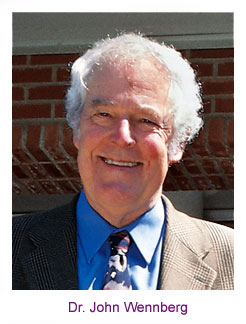|
|
For Release: October 7, 2004
Contact: DMS Communications(603) 650-1492
Print Version
Dartmouth Studies Show Wide Variations in Hospital Care
and Outcomes for Chronically Ill Medicare Patients
Study Questions Performance of Leading Hospitals
HANOVER, NH - Medicare patients with similar chronic conditions receive strikingly different care, even among top-rated hospitals identified as "best" for geriatric care, according to Dartmouth Medical School studies released today. The articles, featured in the October 7 web-exclusive edition of the journal Health Affairs, show that the frequency of physician visits, the number of diagnostic tests, and rate of hospital and intensive care unit (ICU) stays vary markedly. The research results show that a higher intensity of care and higher level of spending are not associated with better quality or longer survival times even in the most renowned teaching hospitals.

In fact, there is evidence that a very high intensity of care for people with certain terminal medical conditions might hasten death, according to lead author of one article, Dr. John E. Wennberg, professor of community and family medicine and of medicine at Dartmouth Medical School (DMS). New findings identify, by hospital, where Medicare enrollees are receiving much more intensive care for common medical conditions, raising questions about usual methods of identifying "best" hospitals.
The studies featured in Health Affairs were released today at a Washington, DC briefing, sponsored by The Robert Wood Johnson Foundation, which funds the Dartmouth Atlas of Health Care project, that describes how medical resources are distributed and used in the United States.
Wennberg, the series editor of the Dartmouth Atlas and director of the Center for the Evaluative Clinical Sciences at DMS, has documented significant geographic variations in medical practice since the early 1970s. He says the significance of these findings is that "for the first time we can use Medicare claims data to measure the performance of individual hospitals and identify those hospitals that appear to be doing a better job managing chronic illness and patient care."

The studies prove that "no matter how preeminent the institution, the care varies all over the ballpark," Wennberg says. "It is clear that quality is inversely correlated with the intensity of care and that the better hospitals are using fewer resources and providing fewer hospitalizations and physician visits."
In the first DMS study, Wennberg and colleagues evaluated the efficiency of 77 hospitals deemed "best" for geriatric care and heart and pulmonary disease in managing chronically ill Medicare patients during the last six months of life. The authors looked at variations in care for more than 90,616 patients age 65 and older suffering from solid tumor cancers, congestive heart failure, and chronic obstructive pulmonary disease, comparing the illness-adjusted frequency of physician visits, hospitalizations, and ICU stays. They found striking variations in the amount of care provided with no association between higher intensity of interventions and better outcomes.
The quality of care for those with terminal illnesses also varied widely. The number of patients who died as hospital inpatients, rather than at home or in hospice, varied from 32 percent of all deaths to more than 52 percent, despite the fact that the vast majority of Americans say they would rather not be in the hospital at the time of death.

A complementary study coauthored by Dr. Elliott Fisher, professor of community and family medicine and of medicine at DMS, looked at patients who received their initial hospitalization for one of three reasons - heart attack, colorectal cancer, and hip fracture - in one of 299 hospitals that belong to the Council of Teaching Hospitals.
Fisher and DMS colleagues examined patterns of practice, quality of care, and health outcomes in teaching hospitals. In fact, they found that the overall intensity of medical services delivered to patients with serious chronic illnesses varied by up to 60 percent.
Their conclusions: patients in the highest-intensity hospitals spend more time in the hospital and ICU; have more frequent physician visits in the inpatient setting; have more specialists involved in their care; and receive more imaging services, diagnostic testing, and minor procedures.
The authors also examined long-term mortality rates for patients cared for in hospitals of differing intensity levels and found no association between higher intensity of care and improved survival. Among hip fracture patients, there were no significant differences in death rates across groups. Among heart attack and colorectal cancer patients, there actually "was a small but statistically significant increase in the risk of death as intensity increased."
Although Wennberg, says medical practice variation is "remarkably resistant to change," he believes there are steps the private and public sectors can take to begin to reduce disparities, such as rewarding providers for efficient, high-quality performance. A provision in the Medicare Prescription Drug, Improvement, and Modernization Act (MMA) of 2003 that creates a demonstration to test out this idea is a giant step in the direction of addressing unwarranted variation in health care, he says.
-DMS-